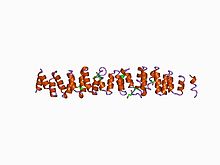
Back كلاثرين Arabic ক্ল্যাথ্রিন Bengali/Bangla Klatrin BS Clatrina Catalan Klathrin Czech Clathrin German Clatrina Spanish کلاترین Persian Clathrine French Clatrina Galician
| Clathrin heavy N-terminal propeller repeat | |||||||||
|---|---|---|---|---|---|---|---|---|---|
 Clathrin terminal domain | |||||||||
| Identifiers | |||||||||
| Symbol | Clathrin_propel | ||||||||
| Pfam | PF01394 | ||||||||
| Pfam clan | CL0020 | ||||||||
| InterPro | IPR022365 | ||||||||
| SCOP2 | 1bpo / SCOPe / SUPFAM | ||||||||
| |||||||||
| Clathrin heavy-chain linker | |||||||||
|---|---|---|---|---|---|---|---|---|---|
 clathrin heavy chain proximal repeat (linker) | |||||||||
| Identifiers | |||||||||
| Symbol | Clathrin-link | ||||||||
| Pfam | PF09268 | ||||||||
| Pfam clan | CL0020 | ||||||||
| InterPro | IPR015348 | ||||||||
| SCOP2 | 1b89 / SCOPe / SUPFAM | ||||||||
| |||||||||
| CHCR/VPS 7-fold repeat | |||||||||
|---|---|---|---|---|---|---|---|---|---|
| Identifiers | |||||||||
| Symbol | Clathrin_propel | ||||||||
| Pfam | PF00637 | ||||||||
| Pfam clan | CL0020 | ||||||||
| InterPro | IPR000547 | ||||||||
| SMART | SM00299 | ||||||||
| PROSITE | PS50236 | ||||||||
| CATH | 1b89 | ||||||||
| SCOP2 | 1b89 / SCOPe / SUPFAM | ||||||||
| |||||||||
| Clathrin light chain | |||||||||
|---|---|---|---|---|---|---|---|---|---|
| Identifiers | |||||||||
| Symbol | Clathrin_lg_ch | ||||||||
| Pfam | PF01086 | ||||||||
| InterPro | IPR000996 | ||||||||
| PROSITE | PDOC00196 | ||||||||
| SCOP2 | 3iyv / SCOPe / SUPFAM | ||||||||
| |||||||||
Clathrin is a protein that plays a major role in the formation of coated vesicles. Clathrin was first isolated by Barbara Pearse in 1976.[1] It forms a triskelion shape composed of three clathrin heavy chains and three light chains. When the triskelia interact they form a polyhedral lattice that surrounds the vesicle. The protein's name refers to this lattice structure, deriving from Latin clathri meaning lattice.[2] Barbara Pearse named the protein clathrin at the suggestion of Graeme Mitchison, selecting it from three possible options.[3] Coat-proteins, like clathrin, are used to build small vesicles in order to transport molecules within cells. The endocytosis and exocytosis of vesicles allows cells to communicate, to transfer nutrients, to import signaling receptors, to mediate an immune response after sampling the extracellular world, and to clean up the cell debris left by tissue inflammation. The endocytic pathway can be hijacked by viruses and other pathogens in order to gain entry to the cell during infection.[4]
- ^ Pearse BM (April 1976). "Clathrin: a unique protein associated with intracellular transfer of membrane by coated vesicles". Proceedings of the National Academy of Sciences of the United States of America. 73 (4): 1255–1259. Bibcode:1976PNAS...73.1255P. doi:10.1073/pnas.73.4.1255. PMC 430241. PMID 1063406.
- ^ "clathrate, adjective". Merriam-Webster. Retrieved 29 November 2023.
- ^ Pearse BM (September 1987). "Clathrin and coated vesicles". EMBO J. 6 (9): 2507–12. doi:10.1002/j.1460-2075.1987.tb02536.x. PMC 553666. PMID 2890519.
- ^ "InterPro". Archived from the original on 2016-01-16. Retrieved 2015-10-07.
© MMXXIII Rich X Search. We shall prevail. All rights reserved. Rich X Search